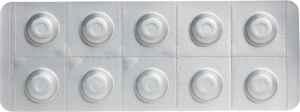There are many ways of treating environmental allergies, and several common ones include antihistamine medications and allergy shots or a combination of the two methods. However, new research is suggesting that sublingual immunotherapy (SLIT) may be an option for treating hayfever symptoms associated with specific weed, grass, and dust mite triggers.
Currently, subcutaneous allergy immunotherapy, or allergy shots, are administered in increasing doses over time until a maintenance dose is reached. Patients generally continue on subcutaneous immunotherapy for 3-5 years based on their allergist’s’ recommendations. Sublingual immunotherapy works similarly, given in regular doses to desensitize patients to a particular antigen, such as a weed or grass. However, unlike subcutaneous immunotherapy, which is administered as shots, sublingual therapy is administered in tablet form under the tongue. Over time, our bodies build tolerance to the specific antigen and the inflammatory immune response is muted, allowing for relief in symptoms like sneezing, itchy eyes, and nasal congestion. SLIT can also help alleviate lower respiratory issues such as shortness of breath and wheezing that may be exacerbated through inhalation of a specific pollen trigger.
 Like any other treatment, there are both advantages and limitations to SLIT. Advantages include the ability of patients to self administer sublingual tablets, which is more convenient. However, seeing as this medication will be administered in a home setting, patient’s will still need to exercise precautions and receive detailed guidelines from their allergist before beginning the treatment. SLIT also carries a lower risk of localized, systemic, and anaphylactic reactions compared with subcutaneous immunotherapy, but much of the research is still new. There are still several side effects of the therapy, including itching of the mouth and digestive issues, which primarily occur in the early stages of treatment.
Like any other treatment, there are both advantages and limitations to SLIT. Advantages include the ability of patients to self administer sublingual tablets, which is more convenient. However, seeing as this medication will be administered in a home setting, patient’s will still need to exercise precautions and receive detailed guidelines from their allergist before beginning the treatment. SLIT also carries a lower risk of localized, systemic, and anaphylactic reactions compared with subcutaneous immunotherapy, but much of the research is still new. There are still several side effects of the therapy, including itching of the mouth and digestive issues, which primarily occur in the early stages of treatment.
The most significant limitation for SLIT is its lack of effectiveness to treat polysensitized patients. This means that SLIT is most effective only for people who react significantly to one specific weed, grass, or dust mite allergen, and would have minimal effect for those whose triggers include a wide variety of trees, grasses, weeds, and animal dander.
Currently, the only forms of SLIT approved by the FDA are tablets for ragweed, northern prairie grasses, and dust mites, so the range of allergens available are minimal at this time. Finally, many insurances may not cover the treatment, so expenses may vary based on the plan type.
Is Sublingual Immunotherapy (SLIT) for you?
In order to determine whether you are a suitable candidate for SLIT, the first step is to consult with an allergist and get skin tested for environmental allergens. This panel will include a diverse array of trees, grasses, weeds, and molds in addition to dust mites and animal dander. Based on the results of your skin prick test, your allergist will be able to determine whether you may qualify to start SLIT. If you react significantly to only ragweed, timothy, or dust mite, you may consider starting SLIT; however, if you react to more than one allergen, your allergist will most likely recommend traditional subcutaneous therapy for better outcomes.
How do you use SLIT?
After you undergo allergy skin prick testing at your allergist’s office, you will be prescribed a tablet corresponding to the major trigger you reacted to, such as ragweed or timothy. Your allergist will develop a custom treatment plan for you, but typically, you will be taking a daily tablet. If you are using tablets for ragweed or timothy, you will start taking tablets 12 weeks before the ragweed pollen season starts and continue everyday throughout the season. For dust mites, you will typically take the tablet year round. Since pollen seasons can vary depending on your area of residence, you will want to discuss the optimal time frame in which to take the tablets with your allergist.
The medications commercially available for SLIT currently are Ragwitek for ragweed, Grasstek for timothy, Odactra for dust mite, and Oralair for a combination of orchard, timothy, perennial ryegrass, and kentucky bluegrass.
The first tablet must be taken at a doctor’s office and you will be monitored to ensure that you do not experience any adverse reactions. Your allergist will also prescribe you an epipen for the duration of the treatment as a precaution for any rare instances of anaphylactic reactions that may be experienced during self-administration. In order for the treatment to be most effective, the tablet needs to be placed under the tongue for 1-2 minutes and then swallowed. You may not eat or drink for 5 minutes after taking the tablet.
Does it work?
The efficacy of SLIT is still being studied, but data shows that patients did experience improvement in their symptoms and were able to decrease their use of medications during the treatment. SLIT has a comparable efficacy to subcutaneous immunotherapy, when used in patient with sensitivity to only one allergen, and provided the treatment is continued up to 3-5 years.
If you are interested in starting SLIT, consult with your allergist to see if this is an option for you. You may be a good candidate for this treatment or subcutaneous immunotherapy along with your current medication regimen. Pursuing immunotherapy is the first step towards experiencing better relief in your symptoms and an improved quality of life!
Sources:
https://acaai.org/allergies/allergy-treatment/allergy-immunotherapy/sublingual-immunotherapy-slit
https://www.aaaai.org/conditions-and-treatments/drug-guide/sublingual-immunotherapy-slit-tablet
https://www.allergychoices.com/about-allergy-drops/how-sublingual-immunotherapy-works/
Sublingual immunotherapy for allergic rhinitis: systematic review and meta-analysis https://www.ncbi.nlm.nih.gov/pubmed/15575924
Sublingual immunotherapy: A comprehensive review https://www.jacionline.org/article/S0091-6749(06)00518-5/fulltex
Sublingual Immunotherapy: A Useful Tool for the Allergist in Private Practice https://www.ncbi.nlm.nih.gov/pmc/articles/PMC4906203/

